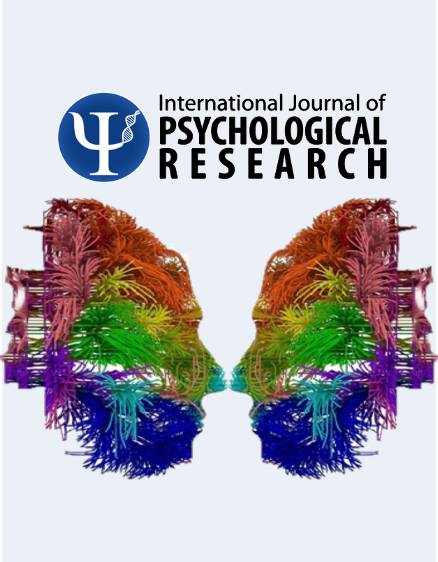To give up copyright, the authors allow that, International Journal of Psychological Research, distribute the work more broadly, check for the reuse by others and take care of the necessary procedures for the registration and administration of copyright; at the same time, our editorial board represents the interests of the author and allows authors to re-use his work in various forms. In response to the above, authors transfer copyright to the journal, International Journal of Psychological Research. This transfer does not imply other rights which are not those of authorship (for example those that concern about patents). Likewise, preserves the authors rights to use the work integral or partially in lectures, books and courses, as well as make copies for educational purposes. Finally, the authors may use freely the tables and figures in its future work, wherever make explicit reference to the previous publication in International Journal of Psychological Research. The assignment of copyright includes both virtual rights and forms of the article to allow the editorial to disseminate the work in the manner which it deems appropriate.
The editorial board reserves the right of amendments deemed necessary in the application of the rules of publication.
Abstract
The results of three different groups of customers, each exposed to a different sales technique, were compared in order to evaluate which sales technique was more effective for achieving higher levels of sustained attention. The study used the Neurosky headband to measure brainwaves in millivolts. The three compared sales techniques were: 1) the training technique for sale, termed as structured by the AIDA model; 2) the traditional sale, here called unstructured; 3) and a structured technique with the help of simultaneous stimulation by several neuroattentional pathways, prescribed by the developments of the neuroscience of consumption (CN). The results showed a statistically significant difference in achieved sustained attention levels, presenting higher levels in clients exposed to the sales training technique and ower scores in those exposed to one of the techniques used by the CN. These results are discussed in relation to the concept of sustained attention in clients when the stimulation of a single neuroattentional pathway is used as compared to the activation of several pathways simultaneously.
Keywords:
References
Aslam, M. (2006). Are you selling the right color? A Cross cultural review of color as a marketing cue. Journal of Marketing Communication, 12 (1), 15-30. doi:10.1080/13527260500247827
Bruya, B., & Tang, Y. Y. (2018). Is attention really effort? Revisiting Daniel Kahneman’s influential 1973 book attention and effort. Frontiers in psychology, 9, 1133. doi:10.3389/fpsyg.2018.01133
Carrillo, CM., & Restrepo, FL. (2009). Efectos de un Entrenamiento Cognitivo de la atención en el funcionamiento de la memoria de trabajo durante el envejecimiento. Acta Neurológica Colombiana. 25(4): 244-251.
Crowley, K., Sliney, A., Pitt, I., & Murphy, D. (2010, July). Evaluating a brain-computer interface to categorise human emotional response. In 2010 10th IEEE International Conference on Advanced Learning Technologies (pp. 276-278). IEEE.
Hubert, M., & Kenning, P. (2008). A current overview of consumer neuroscience. Journal of Consumer Behaviour: An International Research Review, 7(4-5), 272-292. doi:10.1002/cb.251
Kalliny, M., & Gentry, L. (2010). Marketing in the 22nd century: A look at four promising concepts. Asian Journal of Marketing, 4(3), 94-105. doi: 10.3923/ajm.2010.94.105
Hultén, B. (2011). Sensory Marketing: The Multisensory Brand-Experience Concept. European Business Review. 23(3), 256-273. doi:10.1108/09555341111130245
Lampit A, Ebster C, & Valenzuela M. (2014) Multi-domain computerized cognitive training program improve performance of bookkeeping task: a matched-sampling active-controlled trial. Frontiers in Psychology, 5(794): 1-7. doi:10.3389/fpsyg.2014.00794
Lewis-Peacock, J. A., & Postle, B. R. (2012). Decoding the internal focus of attention. Neuropsychologia, 50(4), 470-478. doi:10.1016/j.neuropsychologia.2011.11.006
Morin, C. (2011). Neuromarketing: the new science of Consumer behaviour. Society, 48(2), 131-135. doi: 10.1007/s12115-010-9408-1
Pieters, R. & Wedel, M. (2004). Attention capture and transfer in advertising: Brand, pictorial, and text-size effects. Journal of Marketing, 68(2), 36-50. doi:10.1509/jmkg.68.2.36.27794
Ready, R., Burton, K., & Guix, X. (2010). PNL para Dummies. Barcelona: Grupo Editorial Planeta.
Ruiz-Contreras, A., & Cansino, S. (2005). Neurofisiología de la interacción entre la atención y la Memoria episódica: Revisión de estudios en modalidad visual. Revista de Neurología, 41(12), 733-743.
Sohlberg, Mc., & Mateer, C. (2001). Cognitive Rehabilitation. An Integrative Neuropsichological Approach. The New York: Guilford Press.
Soto GJ. & Restrepo NE. (2008). Entrenamiento para Vendedores. Bogotá: Grupo Editorial Norma, S.A.
Strong, E. K. Jr. (1925). The psychology of selling and advertising. New York: Mcgraw-Hill.
Valencia, E. & Marín, A. (2016a). Impacto de la Utilización del Complemento Nutricional “IN”, en el aumento del % de la masa muscular durante el ejercicio en gimnasios. Revista de la Asociación Colombiana de Nutrición Clínica (ACNC); Abstr. In Press.
Valencia, E., & Marín, A. (2016b) “Impacto de la Reducción del % de desnutrición infantil con el Complemento Nutricional “IN” pediátrico, adicionado a la Bienestarina en el concepto de recuperación nutricional. Revista de la Asociación Colombiana de Nutrición Clínica (ACNC). Abstr. In Press.
Vechiatto, G., Kong, W., Maglione, A., & Wei, D. (2012). Understanding the impact of TV Commercials. IEEE Pulse, 3(3), 42-47.
Van-Zomeren, AH., & Brouwer, WH. (1994). Clinical Neuropsychology of Attention. New York: Oxford University Press.


































